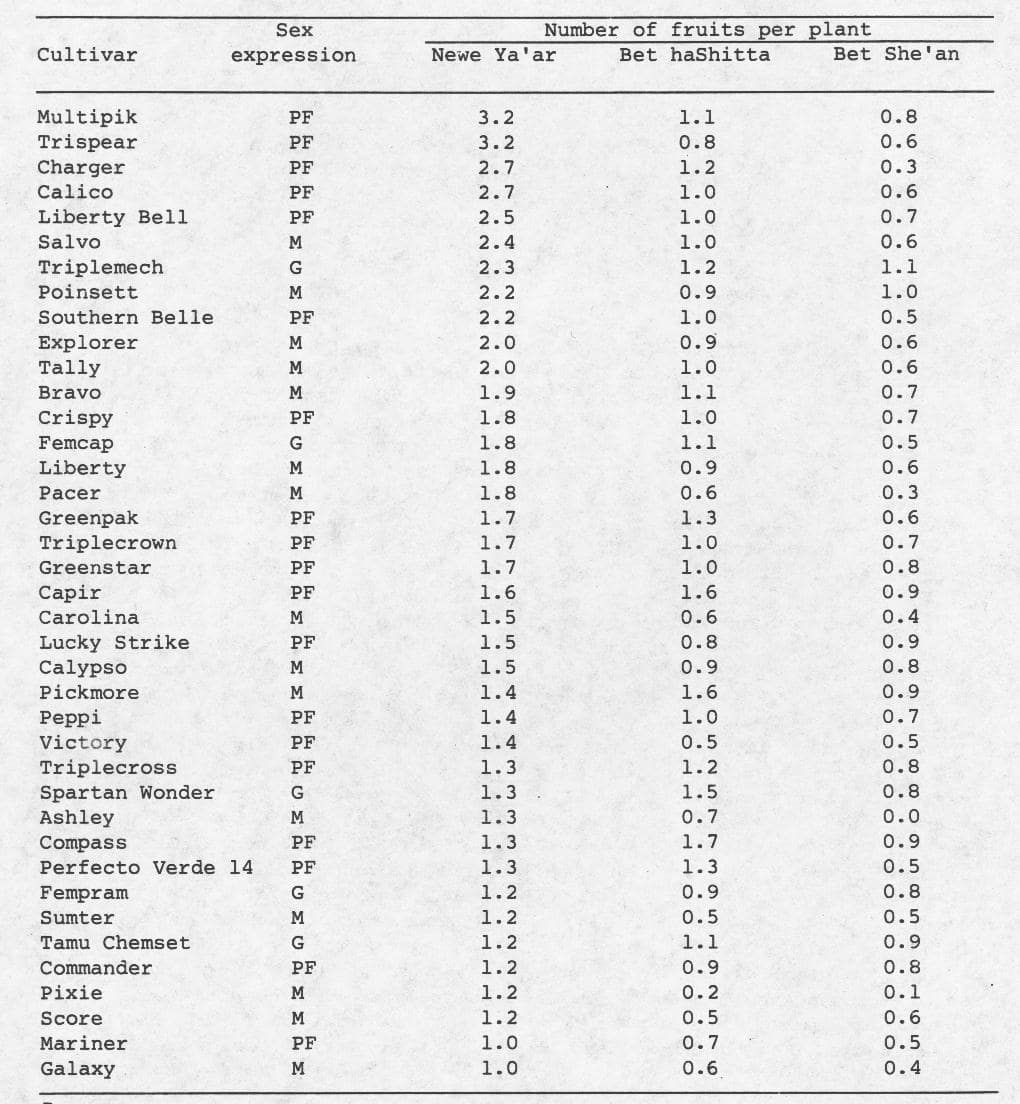Cucurbit Genetics Cooperative Report 10:2-3 (article 2) 1987
Haim Nerson, Harry S. Paris, Zvi Karchi, Anneke Govers, Menahem Edelstein and Yosef Burger
Department of Vegetable Crops, Agricultural Research Organization, Newe Ya’ar Experiment Station, P.O. Haifa, Israel
The shortage and expense of hand labor for multiple harvest of pickling cucumbers are major factors gearing this crop toward mechanized once-over harvest. Accordingly, breeding of new cucumber cultivars for the pickling industry is focused on improving yield concentration. New cultivars of pickling cucumbers are released annually by public and private breeders, and this new genetic material needs to be evaluated for suitability under different cultural practices and climates before it is recommended to the growers.
Plot size is an important consideration for the evaluation of fruit-set concentration in pickling cucumber cultivars. Plots that are too large result in wasted effort and plots that are too small may not give accurate information Results of field experiments have indicated that plots as small as 2 or 3 m2 can give dependable results (1,2). Our objective here was to determine if fruit-set concentration potential under field conditions could be accurately predicted under greenhouse conditions in winter using 6 plants per cultivar.
For this objective 39 pickling cucumber cultivars were grown in a heated greenhouse (minimum night temperature 16°C) at Newe Ya’ar during the winter season of 1982. There were 6 plants per cultivar and the plants were trained to grow on cord hung from stiff wire. The plants were grown on soil mounded on straw bales, distance between plants in the row was 25 cm. A hive of honeybees was provided for pollination. These same cultivars were sown in the open field in April 1982 at 2 locations, Bet haShitta in the Yizre’el Valley and Bet She’an in the Bet She’an Valley. These 2 locations differ in climate and especially soil properties. In the fields, the plants were grown in double rows on raised beds, 2m between bed centers, at a density of 100,000 per hectare. Each cultivar had 4 replications of 6m2 each. A simulated once-over harvest was conducted in the greenhouse and in the fields when 10% of the fruits were oversized. The number of marketable fruits (20-50 mm diameter) per plant is presented in Table 1. Calculation of correlation coefficients among locations shows no correlation between the Newe Ya’ar greenhouse and Bet haShitta or Bet She’an (r=0.15 and r=0.09, respectively) but a highly significant (P <0.01) correlation (r=0.58) exists between Bet haShitta and Bet She’an. The main conclusion is that data obtained under greenhouse conditions using a small number of plants cannot serve to predict fruit-set concentration potential under field conditions.
Table 1. Number of fruits produced per plant in a simulated once-over harvest under greenhouse (at Newe Ya’ar) and field (Bet haShitta and Bet She’an) conditions.

z Sex expression determined in the greenhouse. G indicates <1 male flower per plant; PF indicates ratio of male flowers to female flowers <1.0; M indicates ratio of male flowers to female flowers ≥1.0.
Literature Cited
- Smith, O.S. and R.L. Lower. 1978. Field plot techniques for selecting increased once-over harvest yield in pickling cucumbers. J. Amer. Soc. Hort. Sci. 103:92-94.
- Wehner, T.C. and W.H. Swallow. 1984. Optimum plot size for once-over harvest of pickling and fresh-market cucumbers. Cucurbit Genet. Coop. Rpt. 7:35-36.
Contribution No. 1903-E, 1986 series, from the Agricultural Research Organization, Bet Dagan, Israel.